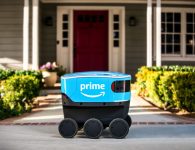

null
Getty
The eGrocery revolution is coming. According to eMarketer, online revenue from U.S. grocery e-commerce is expected to be roughly $20 billion this year and to grow just over 18% year-over-year, meaning that in just four years (i.e. by 2023) direct-to-consumer grocery will be twice the size that it is today.
And, it’s about freaking time too!
The modern day grocery store was invented and has essentially remained unchanged since the days of Piggly Wiggly back in 1916. Yes, you heard that right.
Piggly Wiggly in 1916 invented the full-service grocery store that consumers still know and love to this day. Piggly Wiggly gave Americans things like the shopping cart, checkout lanes, and even price tags on items — all the hallmarks of the modern day grocery experience.
Over 100 years ago!
Sadly, little has changed since. In fact, one could even argue that the modern grocery store experience has devolved into a regionalized sea of sameness, with myriads of players doing their darndest not to upset the apple cart of the status quo.
Progress should have happened long ago.
It didn’t, and now this “status quo” could soon be to Amazon and to other whip smart digital entrepreneurs what baby candy is to a thief — the easiest grab in retail history. What these smart business people all understand is that what got the grocery business here won’t be what gets it there. The “there” will be something quite different and radical.
Overall, three characteristics will define the grocery store of the future:
Center-store grocery will be drastically reduced in size and scope
The direct-to-consumer grocery assault will start first with the center of the grocery store. People may still not trust others to pick their avocados or to squeeze their cantaloupes, but you can bet your bottom dollar that time-starved Americans will soon realize how silly it is to waste time shopping for boxes, tins, and other assorted pre-packaged products that are manufactured over and over again to the same precision tolerances as NASA space parts.
U.S. census figures bear this out — since 2003, Americans are spending far less time shopping. They spent 12 hours shopping per month in 2003, but by 2018 that number declined significantly to just 10 hours.
Everyone knows what is inside the blue and white macaroni boxes or red and white soup cans. Same goes refried beans, dried pasta, salsa, rice, peanut butter, cookies, chips, soda, cereal, etc.
The list could go on and on.
The world over knows what these products are all about, same as shopping for anything else on Amazon. A flat image of a book online is really no different from how many center-store cereal boxes or other grocery products look online too.
So, in a world where less and less time is spent on shopping, center-store grocery products will fall prey to the same fate that has befallen so many other product categories before them. They too will succumb to the push button laziness of American consumerism.
As a result, grocers will start to shrink the square footage they devote to these products, they will start to make their perimeters even more experiential than they are today, and they will likely resort to new in store selling techniques for the products that bridge the divide of digital and physical commerce, e.g. digital pricing and promo boards, in aisle tracking, etc.
Hyperlocal micro-fulfillment will become table stakes
Prior to the last decade, retailers, regardless of the category, could differentiate themselves on brand, assortment, and price. That is not the case anymore. With the rise of e-commerce, mobile technology, and the growing power of younger generations, speed and convenience is now the veritable fourth pillar of retail differentiation.
Amazon has set the bar of consumer expectations so high that consumers believe that they should have whatever they want, whenever they want it. The mentality is already, for many consumers, that the entire world should act as their e-commerce delivery doorsteps.
All of which is why hyperlocal micro-fulfillment and order pickup will be foregone conclusions within every grocery store of the future’s operating plans. Centralized fulfillment simply can’t get to consumers fast enough across the suburban sprawl of the American landscape nor can existing store footprints on their own. New methods for packing, shipping, and delivery have to be devised.
The Walgreens/Kroger partnership is noteworthy for this very fact alone. It is the early stage definition of the modern “grocery store,” one that isn’t so much a place to shop as it is a place of convenience at the right moments within people’s lives.
Same goes for the myriads of ship-from-store initiatives from the likes of Walmart, Target, and others that have turned the nation’s most beloved retailers into last-mile picking and packing hubs.
They too though are all just preambles to a new dawn, to the day when the gasoline really gets thrown on the fire and the tried and true principles of warehouse operations and automation get incorporated into local retail operations as well — a thesis well-validated by the explosion of onsite micro-wareshousing experiments from the likes of Walmart, Stop & Shop, Albertsons, ShopRite, and others that have come out of nowhere in the last year faster than even Billy Ray Cyrus’ career resurgence.
The logic is simple.
Grocery stores are already full of inventory, warehouse picking and packing, especially via automation, is faster and more cost effective than manual labor (whether via third-party or a retailer’s own labor force), and grocery stores also save money on delivery costs because they are closer to consumers from a last-mile perspective.
Just as consumers will no longer need to touch and feel their macaroni and cheese boxes, so too will they soon realize that it isn’t worth their time to play the role of warehouse worker any longer either.
Checkout-free retail is coming
Speaking of better things to do with one’s time, the other elephant in the room is Amazon Go.
Pooh-pooh it all you want, but Amazon Go shows the possible. Forget whether it works at scale, in larger sized boxes, etc.
These points are all moot.
Because it’s 2019!
The technology is already working for Amazon across four different cities (New York, San Francisco, Chicago, and Seattle), so who is to say by 2029 that the technology won’t ubiquitously become what it is today and then some?
It will.
The trade-offs of a checkout-free vs. a stand-in-line checkout experience, all else being equal, are just too great to ignore. Just go back to the above census data on how much less time people are spending shopping. Or, here is a better idea — do an experiment. Go to New York City, get a late night candy bar craving, and ask yourself one question — Amazon Go or the national drugstore chain across the street?
Once you go Go, you’ll never go back.
Sam’s Club, 7-Eleven, Giant Eagle, Tesco overseas and others have all announced plans to implement checkout-free solutions within their current operations. Some rely on mobile scan-and-go solutions, some are closer to the spirit of Amazon Go’s computer vision marvel, and others take a more hybrid approach to the question, but all show just how quickly consumer expectations are changing and just how fast standing in line or interacting with a cashier will become a choice rather than a requirement of the grocery store of the future.
Implications
The implications of the above are not to be taken lightly. They could be drastic on many levels. An Amazon/Whole Foods hybrid lurks on the horizon, like an alien inside John Hurt’s belly, and, as shown above, the retailers well-capitalized enough to press the gas pedal on the future are beginning to do so.
The irony in the above is this — retailers and brands have been built for decades on consistency, on the idea that consumers should know and trust the big brand name on the front of the box. Supply chains have been built around this idea, and so too have marketing plans that assumed consumers shopped in a linear stepwise, almost Mr. Whipple-like progression.
Now things have changed. Consumers shop differently. Supply chains built to ship large amounts of quantities to consolidated locations are not as flexible as those built to handle the demands of e-commerce nor are the linear marketing plans that relied on the store as a place of discovery when compared to what is now accomplished via social media.
Who wins? No one yet knows.
But one thing is certain — the only real answer is to think differently, to look at this future view of the world, not as conjecture, but as fact, and to open up one’s mind to the new opportunities it affords. And, with Groceryshop 2019 just days away, the timing is right to reset the collective context.
Who and what will win are not yet defined and therein lies the opportunity, for the data that underlies this new world is still open to discovery, both by retailers and brands alike. Now is not the time to cling to the Piggly Wiggly past or to put on blinders with a winner-take-all approach.
No, now is the time for collaboration. Now is the time for strength in numbers and for new partnerships across retail, CPG, and tech that do not push against the coming of history but rather give it the shot in the arm that the little piggy needs most.
read more at http://www.forbes.com/retail/ by Chris Walton, Contributor
Business







